In website design, a brand’s logo functions as the most recognizable visual element. When building websites using WordPress page builders such as Elementor, Beaver Builder, or WPBakery, choosing the right placement for the logo isn’t merely a design decision—it’s a critical factor that affects user navigation, brand identity, and responsiveness across devices.
TLDR: Proper logo placement in WordPress builders enhances user experience and fosters brand recognition. The most common placements—header, footer, and mobile views—serve different purposes and should be handled with care. The header is ideal for brand visibility, the footer aids in consistency and site credibility, and optimized mobile placement ensures accessibility. Attention to responsiveness and best UX practices is key.
Contents
Why Logo Placement Matters
The logo’s position influences how users interact with your site. Studies show users tend to seek branding elements in predictable locations—especially the upper-left corner—and instinctively click on logos to return home. A misplaced or hidden logo can cause frustration or disorientation, resulting in higher bounce rates or reduced trust.
WordPress page builders are powerful tools that allow designers to place branding elements anywhere. However, just because you can place a logo anywhere doesn’t mean you should. Strategic placement must balance visibility, usability, and responsiveness.
Logo Placement in the Header
The header is by far the most common and expected position for a logo. It establishes brand presence immediately and usually appears on every page, offering consistency and familiarity.
Common header logo placements include:
- Left-aligned – traditional and most widely used; aligns with left-to-right reading habits.
- Centered – often used for minimalist or modern web designs; may affect navigation layout.
- Right-aligned – rare and unconventional; usually avoided due to usability issues.
Choosing the right alignment depends on your site’s layout, the navigation menu, and overall design language. In WordPress builders like Elementor or Beaver Builder, dragging and positioning a logo is relatively simple via pre-built header blocks or custom headers using row and column structures.

Beyond alignment, logo size, clarity, and padding are also vital. A logo that’s too large can distort your header layout, while one that’s too small might be overlooked. Builders often provide padding, margin, and alignment tools to achieve proportional balance.
Interactive Behavior
An effective header logo should also act as a navigation tool. Best practices dictate that clicking on the logo should redirect users to the homepage. This expectation is so universal that omitting it can decrease usability.
Sticky Headers and Logo Display
Sticky or fixed headers maintain visibility as users scroll. In such cases, the logo typically shrinks or is simplified via a smaller variant to save space. Many WordPress themes and builders allow uploading alternate logos for sticky headers—an often overlooked but powerful branding mechanism.
While the header handles initial brand positioning, footers offer a more subtle but equally important canvas for logo placement. A footer logo provides continuity, especially on longer pages where the header might no longer be visible as the user scrolls.
Reasons to place a logo in the footer:
- Reinforces brand consistency at the bottom of content-heavy pages.
- Builds credibility and signals the end of the navigation journey.
- Integrates with contact information, social icons, or secondary navigation.
With WordPress builders, inserting a logo in the footer is just as straightforward as in headers, often involving drag-and-drop widgets or manually inserting media blocks. Creativity also plays a role, with some sites displaying grayscale or simplified logo variants to maintain subtlety and contrast against darker backgrounds.

However, it’s important not to rely solely on the footer for essential branding. Users typically encounter footers after scrolling extensively, so the footer logo should support—not replace—primary logo placement in the header.
Mobile Logo Placement and Responsiveness
Mobile responsiveness is no longer optional—it’s expected. As mobile traffic often exceeds desktop traffic, your logo’s visibility and clarity on handheld devices are absolutely critical. Yet, mobile designs come with unique constraints: limited screen real estate, touch-based navigation, and varying user behaviors.
Responsive Header Logos
On mobile, logos are often centered or left-aligned within a condensed version of the header. Most WordPress builders allow you to toggle between views (desktop, tablet, mobile) and customize each layout independently. This is essential—if left unchecked, a great desktop logo might turn into an illegibly small image on mobile.
Key considerations for mobile logo placement:
- Scale down the logo while maintaining legibility and aspect ratio.
- Optimize file size for faster load speed without losing clarity.
- Ensure spacing doesn’t interfere with navigation toggles like hamburger menus.
Some mobile headers employ collapsible menus, and placing the logo too close to toggle buttons may lead to accidental taps or create visual clutter. Utilizing builder settings to control margins and order can significantly enhance the mobile UX.
Alternative Mobile Techniques
Depending on your builder’s flexibility, you may choose to hide the logo entirely on mobile to improve performance or use a simplified logomark instead of a full logotype. This approach caters well to speed-focused UI without sacrificing brand recognition—provided the simplified version remains clear and familiar.
Multiple Logos: Use with Caution
Some websites use different logos for different purposes. For example:
- Primary brand logo in the header.
- Partner or sponsor logos in the footer.
- Simplified icons in mobile versions or sticky headers.
While this enhances functionality, overuse can create visual noise and confuse users. A clear hierarchy is crucial. WordPress builders with condition-based visibility (Elementor Pro offers this) enable distinct logos for differing devices or pages without overwhelming the layout.
Logo Format and Technical Considerations
Regardless of placement, logo quality matters. To ensure the best results:
- Use SVG for crisp scalability without resolution loss.
- Ensure transparency for logos placed on variable backgrounds.
- Compress images using tools like TinyPNG without sacrificing appearance.
Many WordPress themes and builders support retina logos—higher resolution images that appear sharper on hi-DPI displays. Uploading a second version sized at 2x (often labeled “@2x”) is a smart step for professional presentation.
Tips for Effective Logo Integration
Combining design, functionality, and performance is key to successful logo integration. Here are some final best practices to follow:
- Always test logo placement on all devices before publishing.
- Keep navigation clean and give logos appropriate breathing room.
- Use visual identity guidelines to maintain logo consistency across placements.
- Employ builder templates to reuse successful designs without redundancy.

Conclusion
Logo placement in WordPress builders should never be an afterthought. It’s a strategic component of your overall design that affects user behavior, brand consistency, and performance metrics. By thoughtfully positioning your logo in the header, footer, and across mobile devices—and using your WordPress builder’s tools effectively—you enhance your site’s credibility and usability.
As websites continue to grow more customized and user-centered, the role of clear and intentional logo placement becomes all the more essential. Whether you’re a developer, designer, or site owner, mastering this design element will elevate your web presence and ensure a consistent brand experience for all users.




